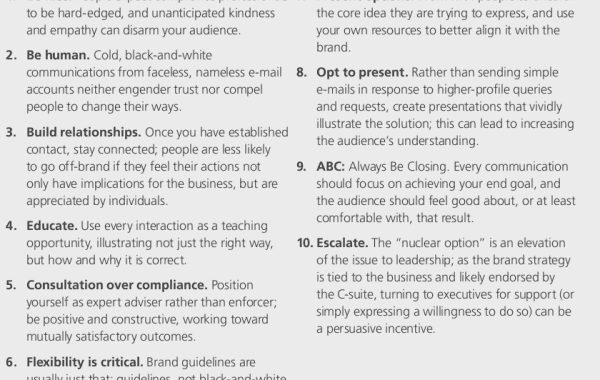Fall is a Good Time for 2026 Planning Is it time to build your next…

Review: Designing B2B Brands” for industrial marketing communications”
Branding lessons from Deloitte and 195,000 brand managers, by Carlos Martinez Onaindia & Brian Resnick.
HOW Magazine introduced us to this 2013 book published by John Wiley & Sons, Inc., it’s about Deloitte’s branding and its implementation throughout the organization. We saw an ad on HOW’s website.
Carlos Martinez Onaindia & Brian Resnick worked for Deloitte while writing the book.
Hubspot included Deloitte and GE websites in one of its promotional blog posts and we recognize them as a good examples of industrial marketing communications design. It’s great news that we can go into more detail with one of our choices.
Number 9. “Always be closing” is close to our heart; it emphasizes the objective of marketing communications. “Every communication should focus on achieving your end goal, and the audience should feel good about, or at least comfortable with, that result,” perfectly sums up landing pages and calls-to-action.
This chart brings to light some of Deloitte’s strategies: “2. Understand – Get under the skin of the client and use the opportunity to better Deloitte’s comparative competitive position, 4. Interact – Take every opportunity to demonstrate our credentials, improve our understanding and test The Deloitte Difference with the client, 8. Capitalize – Make the most of your investment by debriefing the team and the client, learning from what the client tells us, and developing on ongoing strategy to win work from the client.” These strategies can be put to use for industrial equipment selling as well.
This chart illustrates how a company’s strategy’s affects the message, “Lead by example, as their (executives) decisions have a direct impact on brand legacy and will ripple throughout the organization.”
Heinz Loosli, CEO of Feintool International Holding discusses the strategic advantage of Feintool in this interview for its customer magazine. In response to a question about the company’s recovery from the automotive industry decline in 2009, he answers, “We brought new, innovative products to market, we have played more to our strengths and in doing so achieved some great successes in the market. We have also improved our ability to complete by implementing measures to increase efficiency. It is important to appreciate that it is not a case of one-off actions but ongoing commitment that will ensure our company has a successful future. The motto is: achieve more with less. We are constantly working on this…” This statement reflects both the company’s equipment’s strategic advantages but also good business practices. Feintool’s metal part-making equipment takes plate steel and produces parts that are assembly ready without post machining. Their machines achieve more with less material and processing — Loosli is using the same analogy for the company’s management practises. You can download the entire Feintool magazine here. For the North American edition, Lohre & Associates wrote two articles, edited and printed the publication here in Cincinnati. We are honored to work with Feintool’s Cincinnati offices and we feel the company’s marketing communications are equal to Deloitte’s.
Barry Salzberg’s opening message for the book brings to light a similar focus, “There are 195,000 professionals around the world actively shaping the Deloitte identity on a daily basis. Brand-building of that scale requires a relentless focus on a unified vision and shared values, alongside a dynamic culture. There’s tremendous opportunity if you get this right.”
Heather Hancock, Global Managing Partner, Brand, defines Deloitte’s businesss this way: “Deloitte is an advisory business whose brand relies on the daily actions of nearly 200,000 people in more than 150 countries being connected and reflecting the sane core commitments. We connect our people and our brand in myriad ways, always informed by a deep understanding of the marketplace and our clients’ needs. And we take the long view, remaining committed to the task at hand whilst building value for our clients and our own firm long into the future. It delivers us client and personal growth, risk insulation and trust.”
The chart on the left gives insight to the reasons an industrial brand is of value: reputation, risk mitigation, client-building, loyalty and pride leads to the correlation between targeted brand investment and growth rate. Deloitte’s business is deep market understanding to solve client problems. In a way industrial equipment is the same, the equipment is engineered to be an effective way for a company to be in business. Every company has to continually evolve to meet market changes, employee education and financial obligations. Deloitte is in the business of communication; many businesses are in the business of delivering a product. For a manufacturing company to understand the value of brand, it has to have an extremely clear understanding of the technology, engineering, economics of the market and the future. Every component in a machine tells the history of the company’s brand. Someone at every company knows that story and that is where the brand starts.
We’ll continue to look for branding examples that manufacturing company’s can use to improve their marketing communications. If you get in touch to review your brand, we’ll send you the Kindle version of this book. You’ll enjoy it!
We can’t begin to include all the great graphical information and examples in this review. The book covers every conceivable graphic problem and the solutions, meant more for the marketing communications manager of a company than the chief executives. In this review we wanted to climb to the 10,000-foot view of branding that often gets lost when you’re manufacturing industrial equipment. But it does apply and Deloitte does a great job.
Hopefully GE will come out with a similar edition, they are in the machinery business! Writing those specifications and creating 3 views to make the brand come alive is what we do every day.



